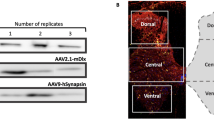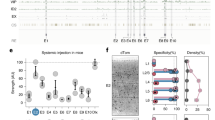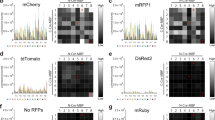Abstract
Focal molecular genetic alteration of the intact mammalian brain will be required to elucidate gene product function in cells comprising synaptic networks. To this end, a somatic mosaic approach has been developed for the mouse whereby a dormant germline transgene is activated by the somatic delivery and expression of cre recombinase. Transgenic mice harboring a recombinational substrate, the germline-transmitted nerve growth factor excision activation transgene (NGF-XAT) were generated. Somatic delivery of virus vectors expressing cre recombinase into the brain of NGF-XAT mice resulted in regional recombination and activation of the transgene as demonstrated at the DNA level by PCR and at the protein level by both immunocytochemistry and ELISA. This approach has been used to evaluate a behavioral correlate of unilateral NGF mosaicism within the dorsal hippocampal formation. NGF-XAT mice activated by expression of cre recombinase manifest increased locomotor activity compared with NGF-XAT mice transduced by a control virus expressing Escherichia coli β-galactosidase. These data indicate that focally increased expression of NGF in one part of a synaptic network can elicit changes in behavior presumably by altering the overall function of NGF-responsive neural circuitry. This approach should have broad application to other gene products and promises to provide the unprecedented ability to create and study discrete genetic modifications in the context of an intact adult mammal.
This is a preview of subscription content, access via your institution
Access options
Subscribe to this journal
Receive 12 print issues and online access
$209.00 per year
only $17.42 per issue
Buy this article
- Purchase on Springer Link
- Instant access to full article PDF
Prices may be subject to local taxes which are calculated during checkout
Similar content being viewed by others
References
Ashburner, M. 1989 Drosophila: a laboratory handbook. Cold Spring Harbor Press, Cold Spring Harbor, NY.
Wang, Y., Krushel, L., and Edelman, G. 1996 Targeted DNA recombination in vivo using an adenovirus carrying the cre recombinase gene. Proc. Natl. Acad. Sci. USA 93: 3932–3936.
Dai, Y., Schwartz, E., Gu, D., Zhang, W., Sarvetnick, N., and Verma, I. 1995 Cellular and humoral immune responses to adenoviral vectors containing factor IX gene: tolerization of factor IX and vector antigens allows for long-term expression. Proc. Natl. Acad. Sci. USA 92: 1401–1405.
Yang, Y., Li, Q., Ertl, C., and Wilson, J. 1995 Cellular and humoral immune resoponses to viral antigens create barriers to lung-directed gene therapy with recombinant adenoviruses. J. Virol. 69: 2004–2015.
Byrnes, A., Rusby, J., Wood, M., and Charlton, H. 1995 Adenovirus gene transfer causes inflammation in the brain. Neuroscience 66: 1015–1024.
Jin, B.K., Belloni, M., Conti, B., Federoff, H.J., Starr, R., Son, J.H. et al. 1996 Long-term in vivo gene expression driven by a tyrosine hydroxylase promoter in a defective herpes simplex virus amplicon vector. Hum. Gene Ther. 7: 2015–2024.
Kaplitt, M., Kwong, A., Kleopoulos, S., Mobbs, C., Rabkin, S., and Pfaff, D. 1994 Preproenkephalin promoter yields region-specific and long-term expression in adult brain after direct in vivo gene transfer via a defective herpes simplex viral vector. Proc, Natl. Acad. Sci. USA 91: 8979–8983.
Gu, H., Zou, Y.-R., and Rajewsky, K. 1993 Independent control of immunoglobulin switch recombination at individual switch regions evidences through cre-loxP-mediated gene targeting. Cell 73: 1155–1164.
Battleman, D., Geller, A., and Chao, M. 1993 HSV-1 vector-mediated gene transfer of the human nerve growth factor receptor p75hNGFR defines high-affinity NGF binding. J. Neurosci. 13: 941–951.
Bergold, P., Cassaccia-Bonnefil, P., Xiu-Liu, Z., and Federoff, H. 1993 Transsynaptic neuronal loss induced in hippocampal slice cultures by a herpes simplex virus vector expressing the GluR6 subunit of the kainate receptor. Proc. Natl. Acad. Sci. USA 90: 6165–6169.
Geschwind, M., Hartnick, C., Liu, W., Amat, J., Van De Water, T., and Federoff, H. 1996 Defective HSV-1 vector expressing BDNF in auditory ganglia elicits neurite outgrowth: model for treatment of neuron loss following cochlear degeneration. Hum. Gene Ther. 7: 173–182.
Xu, H., Federoff, H., Maragos, J., Parada, L., and Kessler, J. 1994 Viral trans-duction of trk A into cultured nodose and spinal motor neurons conveys NGF responsiveness. Dev. Biol. 163: 152–161.
Geller, A. and Breakefield, X. 1988 A defective HSV-1 vector expresses Escherichia coli beta-galactosidase in cultured peripheral neurons. Science 241: 1667–1669.
Geschwind, M., Lu, B., and Federoff, H. 1994 Viral transfection of intrinsic cells within the brain. Expression of neurotrophic genes from HSV-1 vectors: modifying neuronal phenotype. pp. 462–482 in Providing pharmacological access to the brain: a volume of methods in neurosciences. Conn, initials? (ed.). Academic Press, Orlando, FL.
Johnson, P., Miyanohara, A., Levine, F., Cahill, T., and Friedmann, T. 1992 Cytotoxicity of a replication-defective mutant of herpes simplex virus type I. J. Virol. 66: 2952–2965.
Paterson, T. and Everett, R. 1990 A prominent serine-rich region in Vmw175, the major transcriptional regulator protein of herpes simplex virus type 1, is not essential for virus growth in tissue culture. J. Gen. Virol. 71: 1775–1783.
Laemmli, U. 1970 Cleavage of structural proteins during the assembly of the head of bacteriophage T4. Nature 227: 680–685.
Conner, J., Muir, D., Varion, S., Hagg, T., and Manthorpe, M. 1992 The localization of nerve growth factor-like immunoreactivity in the rat basal forebrain and the hippocampal formation. J. Comp. Neurol. 319: 454–462.
Forss-Peter, S., Danielson, P., Catsicas, S., Battenberg, E., Price, J., Nerenberg, M. et al. 1990 Transgenic mice expressing beta-galactosidase in mature neurons under neuron-specific enolase promoter control. Neuron 5: 187–197.
Seeburg, P. 1982 The human growth hormone gene family: nucleotide sequences show recent divergence and predict a new polypeptide hormone. DNA 1: 239–249.
Tantravahi, J., Alvira, M., and Falck-Pedersen, E. 1993 Characterization of the mouse beta maj globin transcription termination region: a spacing sequence is required between the poly(A) signal sequence and multiple downstream termination elements. Mol. Cell Biol. 13: 578–587.
Federoff, H., Geschwind, M., Geller, A., and Kessler, J. 1992 Expression of nerve growth factor in vivo, from a defective HSV-1 vector prevents effects of axotomy on sympathetic ganglia. Proc. Natl. Acad. Sci. USA 89: 1636–1640.
Palmer, T., Miller, A., Reeder, R., and McStay, B. 1993 Efficient expression of a protein coding gene under the control of an RNA polymerase promoter. Nucleic Acids Res. 21: 3451–3457.
Author information
Authors and Affiliations
Corresponding author
Rights and permissions
About this article
Cite this article
Brooks, A., Muhkerjee, B., Panahian, N. et al. Nerve growth factor somatic mosaicism produced by herpes virus-directed expression of ere recombinase . Nat Biotechnol 15, 57–62 (1997). https://doi.org/10.1038/nbt0197-57
Received:
Accepted:
Issue Date:
DOI: https://doi.org/10.1038/nbt0197-57
This article is cited by
-
Neuronal Specificity of HSV/Sleeping Beauty Amplicon Transduction In Utero Is Driven Primarily by Tropism and Cell Type Composition
Molecular Therapy (2007)
-
Viral vectors for gene delivery to the nervous system
Nature Reviews Neuroscience (2003)
-
Conditional control of gene expression in the mouse
Nature Reviews Genetics (2001)
-
HSV-1-Based Vectors for Gene Therapy of Neurological Diseases and Brain Tumors: Part II. Vector Systems and Applications
Neoplasia (1999)



